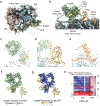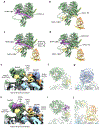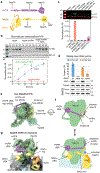NAC guides a ribosomal multienzyme complex for nascent protein processing
- PMID: 39169182
- PMCID: PMC12039536
- DOI: 10.1038/s41586-024-07846-7
NAC guides a ribosomal multienzyme complex for nascent protein processing
Abstract
Approximately 40% of the mammalian proteome undergoes N-terminal methionine excision and acetylation, mediated sequentially by methionine aminopeptidase (MetAP) and N-acetyltransferase A (NatA), respectively1. Both modifications are strictly cotranslational and essential in higher eukaryotic organisms1. The interaction, activity and regulation of these enzymes on translating ribosomes are poorly understood. Here we perform biochemical, structural and in vivo studies to demonstrate that the nascent polypeptide-associated complex2,3 (NAC) orchestrates the action of these enzymes. NAC assembles a multienzyme complex with MetAP1 and NatA early during translation and pre-positions the active sites of both enzymes for timely sequential processing of the nascent protein. NAC further releases the inhibitory interactions from the NatA regulatory protein huntingtin yeast two-hybrid protein K4,5 (HYPK) to activate NatA on the ribosome, enforcing cotranslational N-terminal acetylation. Our results provide a mechanistic model for the cotranslational processing of proteins in eukaryotic cells.
© 2024. The Author(s), under exclusive licence to Springer Nature Limited.
Figures













References
-
- Aksnes H, Drazic A, Marie M & Arnesen T First Things First: Vital Protein Marks by N-Terminal Acetyltransferases. Trends Biochem Sci 41, 746–760 (2016). - PubMed
-
- Wiedmann B, Sakai H, Davis TA & Wiedmann M A protein complex required for signal-sequence-specific sorting and translocation. Nature 370, 434–440 (1994). - PubMed
-
- Gamerdinger M et al. Early Scanning of Nascent Polypeptides inside the Ribosomal Tunnel by NAC. Mol Cell 75, 996–1006.e8 (2019). - PubMed
ADDITIONAL REFERENCES.
-
- Yin J, Lin AJ, Golan DE & Walsh CT Site-specific protein labeling by Sfp phosphopantetheinyl transferase. Nat Protoc 1, 280–285 (2006). - PubMed
-
- Walker KW & Bradshaw RA Yeast methionine aminopeptidase I. Alteration of substrate specificity by site-directed mutagenesis. J Biol Chem 274, 13403–13409 (1999). - PubMed
MeSH terms
Substances
Grants and funding
LinkOut - more resources
Full Text Sources

